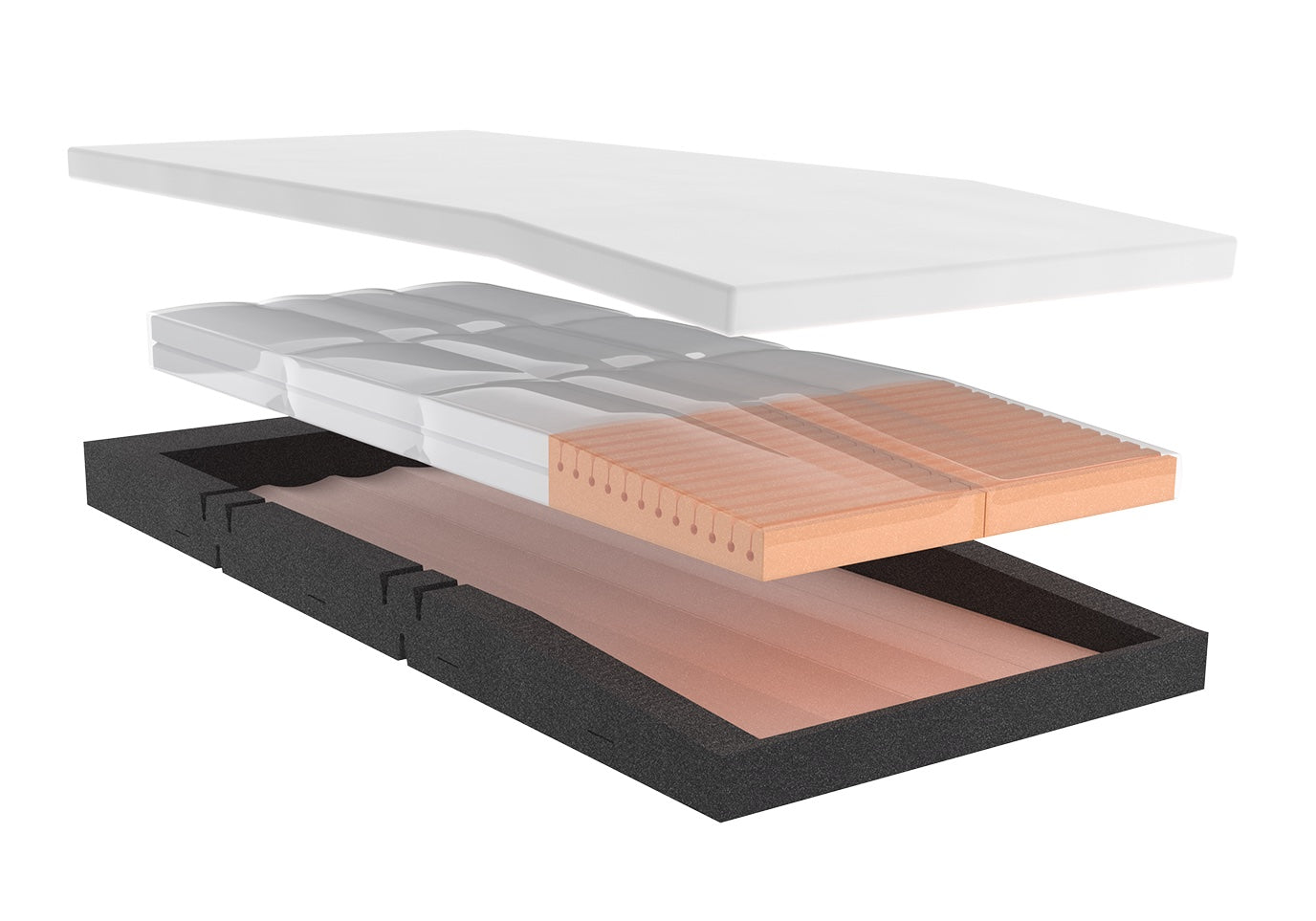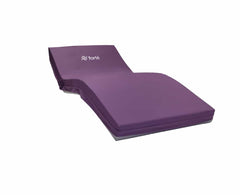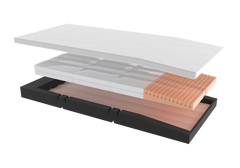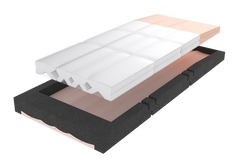We’re Just a Call Away!
Need help? Give us a call for a free consultation with one of our specialists.
Mobility Scooters, Sunshine Coast





SKU: ALS1000
Couldn't load pickup availability
At Kineticare, we're committed to offering not only the highest quality mobility solutions but also the best value for our clients. That's why we proudly introduce our Price Beat Guarantee. If you find a lower price from an identical local competitor, we promise to not just match it, but beat it. We're committed to providing you with premium products at unbeatable prices, ensuring you can choose Kineticare with confidence for all your mobility needs.
Experience the Kineticare difference - superior products, unparalleled service, and our Price Beat Guarantee. Contact us today to learn more!
REACTIVE SUPPORT SURFACES
A Reactive support surface is a powered or non-powered support surface with the capability to change its load distribution properties only in response to applied load. Reactive support surfaces may be powered (active) or nonpowered (static). In comparison to an alternating pressure relieving mattress, reactive surfaces provide a constant low-pressure profile whereby the pressure at every contact point is reduced. The patient is able to immersion and is enveloped by the surface which increases the area of contact with the patient’s body and the reactive support surface.
Reactive support surfaces come in many different types including:
Foam – mattress composed of foam or layers of foam with different densities and shapes. For example, Forté Sovereign High Care Mattresses.
Air or Gel Filled – surfaces comprise air or gel-filled compartments. For example, ROHO Integrated Systems.
Hybrid – surface combining foam and air technology to maximise the benefits offered by both static and alternating surfaces.
Low air loss – some air-filled support surfaces allow air to escape through small holes. The air flows along the inside of a vapour permeable patient contact layer. This draws moisture and heat through the contact layer and away from the skin. Low air loss aids control of moisture on a patient’s skin.
Air-fluidised – contain sand-like particles through which air is forced. As the air is forced through the particles, they take on the properties of a liquid. The porous cover allows air to escape out of the mattress and body fluids to flow down into the support surface
Non-powered reactive or hybrid support surfaces work on the principle of air displacement. When a person repositions their weight, air moves within the mattress to surrounding cells for optimum pressure redistribution. This allows the mattress to conform to the shape of the person’s body as they move, increasing the surface area In contact with the mattress and reducing the patient/support surface interface pressures. This minimises the potential for cell and tissue breakdown.
STABILITY AND AIR SYSTEMS
Air is used in support surfaces as it is a very versatile means to displace pressure, however, air can also create a surface that feels unstable.
Although immersion is of utmost importance to reduce interface pressure on a reactive support surface, it must not compromise the ability of the individual to reposition or enter/exit their bed.
Many reactive systems currently in the market have very little control over where the air can travel, throughout the entire mattress, in particular with side-to-side movement. Air within the Alaise is contained in cells horizontally to maintain lateral stability and vertically, preventing air from ‘running away’ to uncontrolled areas of the mattress.
The firm foam sides and foundation surrounding the Alaise air system create essential, additional stability – preventing bottoming out and assisting with safe transfers.
IMPORTANCE OF PATIENT COMPLIANCE FOR HIGH-RISK INDIVIDUALS
The Alaise Pumpless Hybrid mattress can be used in applications where high to very high risk individuals require a high care air mattress system that is comfortable and stable.
Non-powered and non-alternating air systems such as the Alaise are typically preferred to active air systems as there is less movement, stability, and noise related discomfort.
Why is it so important to select a support surface that is comfortable?
Comfort = Compliance
When pain is relieved by the support surface:
The individual is more sensitive to discomfort and pain which may indicate concentrated pressure – a warning sign that there is a risk of pressure injury formation
Better sleep = less fatigue = more stamina = better physical and mental endurance for client and caregivers
Reduces need for pain and sleep medication – improves cognitive state, less strenuous care regimens
Reduces the risk of the individual refusing to sleep on the prescribed mattress, resorting to a non-compliant surface such as a recliner chair
SLOPED HEEL REGION
The heels are one of the most susceptible sites for pressure injuries, due to factors such as heel anatomy, disease burden, comorbid conditions, and the aging process. Heel Pressure Injuries (HPI) has been found to be one of the most prevalent sites for pressure injuries to occur, with a study in Europe identifying that 38.5% of stage IV pressure injuries were found at the heels. Pressure upon the Calcaneus can be reduced and redistributed by elevating the lower leg and calf .
Many Static Air Systems do not include the Heel section of the mattress as part of the Air system, where the air cells stop at the calf area. The Alaise incorporates air cells from head to foot, ensuring that the heels are fully protected. The Alaise is designed with an air zone dedicate to protecting the heels – incorporating a heel slope with a softer Immersion area.
There are three primary designs of heel elevation: the Heel Slope (Surface Modification), Heel elevator (external device) and the elevated Heel slope (Hybrid Model).
Though essential in the clinical setting, and particularly with those that are medically complex, elevating the heel and redistributing the pressure towards the calf is a difficult task. There are several implementation considerations such as ensuring the knee is at a slight flexion (5-10°) while the heel is elevated can help avoid vein compression and increased risk of deep vein thrombosis (DVT), adapting a plan of care to the individuals’ needs and avoiding causing harm to other ‘at-risk’ areas of the body (such as the Achilles tendon).
With patients on a traditional support surface with a completely horizontal fascia (no heel slope) and no additional aid from an external heel device, pressure injuries upon the heel region are more common than with heels that have elevated heels, with differences being from an 8% to 54.2% incidence on heel injury respectively.
Forté has conducted studies to illustrate the basic principles of heel offloading using a Tekscan Pressure Measurement System which utilises a thin and flexible sensor. We use this system to measure the pressure distribution of a human body on the surface of our mattresses with minimal interference.
The image demonstrates the pressure distribution of the NPIAP/RESNA 50th Percentile male mannequin (81.2kg, 1775mm tall) over a 6-hour period, shown in a variety of heel positions. The Support surface used is a Single Sovereign S3 High-Care Mattress.
Such a decrease in pressure, therefore, signifies the importance of heel offloading, and indirectly the importance of utilising a support surface modified with a heel slope as a means of offloading such pressure and reducing risk of an HPI. Furthermore, the heel slope was identified to encourage a slight bend in the knee of approximately 8-10°, in comparison to a flat surface which evidence has suggested reduces popliteal vein compression.
Sizes and Availability
ALS1000 - Stocked - Single
ALSL1000 - Stocked - Long Single
ALKS1000 - Stocked - King Single
ALKSL1000 - Stocked - Long King Single
ALEW1000 - Made to Order - Extra Wide
ALEWL1000 - Made to Order - Long Extra Wide
ALD1000 - Made to Order - Double
ALDL1000 - Made to Order - Long Double
ALQ1000 - Made to Order - Queen
ALQL1000 - Made to Order - Long Queen
ALK1000 - Made to Order - King
ALKL1000 - Made to Order - Long King
ALSQ1000 - Made to Order - Split Queen
ALSQL1000 - Made to Order - Long Split Queen
As a registered NDIS provider, Kineticare recognises the significance of collaborating with plan managers and NDIS participants to deliver optimal support and care.
Kineticare is committed to providing high-quality, cost-effective, and accessible back care and mobility products to NDIS participants throughout Australia. We take pride in being a reliable partner for plan managers and the broader disability community. For more information or to request a quote, please click the link above or click here.
Thanks for subscribing!
This email has been registered!
| Product | SKU | Rating | Description | Collection | Availability | Product Type | Other Details |
|---|
Need help? Give us a call for a free consultation with one of our specialists.